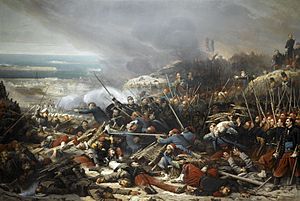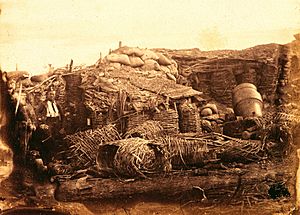Battle of Malakoff facts for kids
Quick facts for kids Battle of Malakoff |
|||||||
|---|---|---|---|---|---|---|---|
| Part of the siege of Sevastopol and the Crimean War | |||||||
 The Battle of Malakoff by Adolphe Yvon |
|||||||
|
|||||||
| Belligerents | |||||||
| Commanders and leaders | |||||||
| Strength | |||||||
|
70,500
|
59,500
|
||||||
| Casualties and losses | |||||||
|
1st assault: 5,000 7,546 to 10,000 |
1st assault: 1,500 13,000 |
||||||
The Battle of Malakoff was a major fight during the Crimean War. It involved French attacks against Russian forces at a strong fort called the Malakoff redoubt. A redoubt is a small, enclosed fort or outpost.
The first attack happened on June 18, 1855, but it failed. The French army, led by General MacMahon, finally captured the Malakoff redoubt on September 8, 1855. At the same time, British troops attacked another fort nearby called the Redan, but they were pushed back. A French soldier, Eugène Libaut, famously raised the French flag over the captured Russian fort.
The capture of Malakoff led to the fall of Sevastopol the next day, September 9. This ended the long 11-month siege of the city.
Contents
Why Was Malakoff Important?
Before 1784, most forts around Sevastopol protected the harbor and naval base. But plans for forts in the surrounding hills began in 1837. The Malakoff-Kurgan ridge was a key part of the city's defenses. It was about 4 kilometers (2.5 miles) southeast of Sevastopol.
On this ridge stood a two-story stone tower. The Russians had placed five heavy cannons on it. This tower was a bit of a mystery, as no one knows exactly when it was built. It was originally built by merchants and later taken over by the Russian Navy. The tower was about 14-15 meters (46-49 feet) wide and 8 meters (26 feet) tall. Inside it was a smaller fort called "Lunette Kamchatka" that protected more cannons.
Russian mapmakers called all important spots around this ridge "Fort Malakoff." This name stuck in Western books about the Crimean War.
The harbor of Sevastopol was protected by Russian warships and strong granite forts. For the city itself, and the area called Korabelnaya, defense plans had been ready for years. The Malakoff Tower protected Korabelnaya, with other forts like the Redan and Little Redan on its sides.
Eduard Totleben, the main Russian engineer, started building these defenses early in the war. He worked hard every day to rebuild and improve the forts. By October 1854, Sevastopol was not yet the super-strong fortress it became. Totleben believed the Allies could have taken the city easily if they had attacked right away. But they waited until October 17 for the first attack.
The Battle for Sevastopol
The First Attacks
On October 17, 1854, a huge artillery battle took place. Russian cannons caused heavy losses for the French. The Allied ships attacking the harbor also lost many men and some ships were damaged.
However, British cannons managed to silence the Malakoff fort. If other attacks had gone well, the Allies might have captured the city then. But by morning, Russian engineers had already fixed and improved the damaged forts.
For many months, the siege continued. The Russians were losing about 250 men every day. So, they decided to try and break the deadlock.
The Battle of Chernaya River
On August 16, 1855, Russian forces attacked 37,000 French and Sardinian troops. The Russians fought very hard, but they failed. By the end of the day, the Russians had lost 8,000 men, while the French and British lost only 1,700. This defeat meant that Sevastopol could not be saved.
The Final Assault
On the same day, a strong bombardment once again weakened the Malakoff fort. Marshal Pélissier then planned the final attack.
At noon on September 8, 1855, French troops suddenly attacked the right side of the Russian defenses. The fighting was very fierce. The French attack on the Malakoff was successful! However, two other French attacks were pushed back.
The British attack on the Redan was successful at first. But a Russian counterattack forced the British out after two hours. Since the French had failed in other areas but had taken Malakoff, further attacks were stopped. The Russian positions around the city could no longer be held.
All day, the heavy shelling killed many Russian soldiers. The fall of the Malakoff meant the end of the siege. That night, the Russians escaped across bridges to the north side of the city. On September 9, the winning Allied forces took over the empty and burning city.
The losses in this final attack were very high. The Allies lost over 8,000 men, and the Russians lost 13,000. Many generals were killed on this last day. With Sevastopol captured, the war was decided. No major battles happened after this. An agreement for peace was made on February 26, 1856, and the Treaty of Paris was signed on March 30, 1856.
What Happened After the Battle?
At first, Russia seemed very strong against sea powers. Even losing Sevastopol might not have seemed like a huge defeat. However, the Russian Tsar had decided to defend Sevastopol at any cost. So, its capture became a very bad defeat for Russia, especially since the Allies won with fewer resources.
The Malakoff fort was very important because it overlooked the whole city and its harbor. After the French troops, led by Marshal Pelissier and General Patrice de Mac-Mahon, captured it, the Russian defenders left the entire city on September 8, 1855. This was a turning point in the war.
Since the fort controlled the Black Sea port of Sevastopol, the Russian forces destroyed all their equipment and left. This meant Russia no longer had military forts on the Black Sea. Their long-held dream of controlling the Black Sea and having free passage to the Mediterranean Sea was now impossible.
The British and French had a big advantage because they could get supplies by sea. The Russians, however, had to bring supplies over bad and dangerous desert roads in southern Russia. Many Russian soldiers and horses died bringing supplies to Sevastopol.
The forts were built quickly and were damaged every day by thousands of cannons. They had to be rebuilt every night. This meant many workers were exposed and suffered heavy losses. These losses used up Russia's resources. When they had to use many untrained soldiers in the Battle of Traktir Bridge, it was clear the end was near.
The famous writer Leo Tolstoy, who was at the siege, wrote stories that showed what the war was like for the Russians. He described the hard desert marches, the terrible conditions in the forts, and the daily danger of fighting under cannon fire.
Among the few surviving defenders of the stone tower on Malakhov Kurgan was Vasily Kolchak. He was the father of Aleksandr Vasiliyevich Kolchak, who later became a leader of the anti-communist forces in the Russian Civil War.
Because of news reports about the siege, Malakhov Kurgan became very well known in Europe. Many large towers in Western Europe were named after it. These included mining towers in Germany and a fort in Mainz. The Malakoff cake and a cheese dish in Switzerland were also named after the Duke of Malakoff, a title given to Marshal Pélissier after the victory.
A suburb of Paris and a street in Paris were also named after this battle. Today, Malakhov Kurgan has an Eternal Fire that remembers the siege of Sevastopol during World War II. A large painting by Franz Roubaud showing the 1855 battle is also there.
Images for kids
-
The Taking of Malakoff by Horace Vernet. A British officer salutes the French flag.





